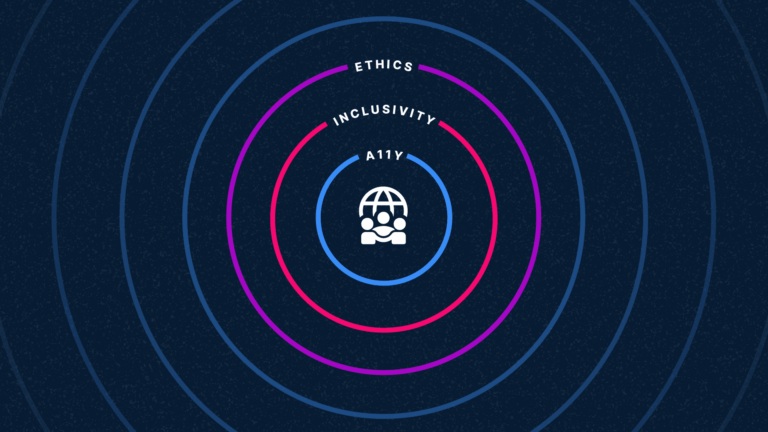5 reasons why prioritizing web accessibility is good for your business

Accessibility on the web is sometimes perceived as a hurdle for business leaders to get over before moving on to other priorities, but there is an increasing amount of evidence showing that implementing web accessibility practices is actually better for business.
Why should companies care about accessibility?
Proactively getting ahead of issues that inaccessible systems, tools, and technology cause will pay dividends in ways you may not have considered. In our experience, helping leaders rethink how they design and build their tools to reach all people is worth the initial investment. After all, inclusion creates innovation as your team looks for ways to make your digital products for everyone. And, while it might seem like the initial investment isn’t worth it, we assure you it will save you money in the long term and help minimize any legal risks. Lastly, in today’s digital landscape, where users are demanding accessibility, your investment will help improve your brand reputation and reach more customers in your market.
1. Inclusion Inspires Innovation
Accessible design thinking provides many ways for users to interact with websites and applications, and having those options is useful for people with and without disabilities. Accessible design is flexible by nature, allowing content to faithfully render across a broad spectrum of devices, platforms, assistive technologies, and operating systems.
Think about the physical environments around you. Everyone takes advantage of lowered curbs, automatic doors, ramps, and other features provided for disability access. These features make it easier to walk around with a stroller, push a shopping cart in and out of the store, and move around with lots of things in your hands. On the web, accessibility features are also often used to the benefit of all.
One compelling example in technology is from the early 2000’s when mobile devices became the primary means to browse the web. Accessible and standards-compliant websites were, in many cases, more mobile-ready as they did not rely on mouse input.
Imagine the benefits of increased traffic and user engagement for those who were already committed to and had proactively designed for accessibility! This mobile-heavy revelation led to the responsive-design trend that has accessibility at its core.
The accessibility problems of today are the mainstream breakthroughs of tomorrow.
– Eve Andersson, Director, Accessibility Engineering, Google
2. You Will Save Money
Simply put, incorporating accessibility at the start of a website development or redesign process is significantly easier and less expensive than making improvements to an existing site later as a separate project.
A Forrester Research Economic Impact Study commissioned by Microsoft concluded that accessibility could contribute to cost savings when it is integrated into existing and ongoing development cycles. Technology updates and redesigns that include accessibility along with other best practices have demonstrated reduced costs for maintenance and service. Moreover, according to Microsoft, as accessibility features are included, overall customer satisfaction improves.
– W3.org
3. Your Brand Reputation Will Improve
Apple. Microsoft. IKEA. Google. These brands are applauded for their diversity and inclusion efforts, including clear, well-integrated accessibility commitments.
A clear commitment to accessibility can demonstrate that a business has a genuine sense of Corporate Social Responsibility (CSR). Potential outcomes for CSR programs include enhanced brand image and reputation, increased sales and customer loyalty, improved workforce diversity, and many other benefits.
Accessibility is a core value at Apple and something we view as a basic human right.
– Sarah Herrlinger, Director of Global Accessibility Policy and Initiatives, Apple
4. You Will Minimize Legal Risk
Speaking of cost savings and brand reputation, web accessibility litigation has been on the rise in recent years, and public-facing consumer organizations are making negative headlines. There are no signs of slowing on this topic.
Don’t let your brand become the latest in a string of cautionary tales on the importance of accessible interfaces.
- 2019 | Supreme Court allows blind people to sue retailers if their websites are not accessible (Los Angeles Times)
- 2018 | Number Of Federal Website Accessibility Lawsuits Nearly Triple, Exceeding 2250 In 2018 (ADA Title III)
- 2008 | Target to pay $6 million to settle site accessibility suit (Ars Technica) – In addition to paying the fine, Target had to invest in a brand new website that was compliant with regulations, a costly process that could have been avoided if accessibility had been a priority from the start.
Accessibility is Anti-Discrimination
Web accessibility will also ensure compliance with anti-discrimination laws, as the U.S. Department of Justice and the FCC are establishing new laws that will require most websites to comply with WCAG 2 Level AA.
5. You Will Extend your Market Reach
Often, businesses consider only permanent disabilities when they’re thinking about this “minority” of their users, but the reality is that disability covers a much broader spectrum.
Disabilities can be permanent, temporary or situational, and often the solution for one benefits all. For example, you can be temporarily disabled if you break your arm and can’t use your mouse for a fixed amount of time. You can experience a situational disability if you are holding a toddler with one arm and ordering dinner to-go on your phone with the other.
The population of people with disabilities is also much more prevalent and expansive than one may think:
The global market of people with disabilities is over 1 billion people with a spending power of more than $6 trillion. Accessibility often improves the online experience for all users.
– W3.org
10% of all adult Americans have some degree of vision loss. That’s 23.7 million American adults age 18+.
Keep in mind that these statistics only account for those who actually report having a disability. Many hide their disability for privacy.
62% of employees with a disability have an invisible disability or a disability that one cannot immediately identify upon meeting a person.
Closing Thoughts: Keep Your Customers
By making digital content accessible, your organization can reach more customers, increase customer satisfaction, and gain a competitive edge over those who don’t include accessibility features. How many users are you losing to competitors simply because their site is more accessible?
71% of people with disabilities leave a website immediately if it is not accessible.
The above-mentioned Forrester Research study found that implementing accessible web design minimizes the rate at which users abandon websites, which results in an estimated additional $2.4 million in annual revenue for Microsoft.
Please don’t hesitate to get in touch if you’re interested in talking more about this topic, which we feel very strongly about.



